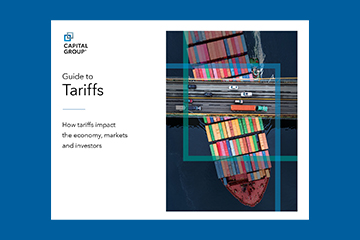Economic Indicators
Macro Brief
The latest round of tariffs launched by the U.S. government in early April prompted a wave of criticism from world leaders, including some who say globalization is now dead. As a global investor for over four decades, I respectfully disagree. Globalization isn’t dead. It is, however, changing in a significant way.
Could it take a step back? Yes, I think it will. There are valid reasons for globalization to go through a policy refresh — at least, the type of globalization that we’ve become accustomed to since the early 1970s when trade expansion started a meteoric rise. In fact, the tectonic plates of world trade have been shifting for some time. Today's changes feel seismic, but trade as a percent of world GDP has moved roughly sideways since the global financial crisis between 2007 and 2009.
A decade later the COVID-19 pandemic revealed some of the problems associated with globalization, as did the Russia-Ukraine war. Both events exposed the vulnerabilities of global supply chains that rely too heavily on single trade routes.
Globalization marches on — at a different pace

Sources: Capital Group, OECD, World Bank. World trade is calculated as the sum of exports and imports of goods and services and represented as a share of global gross domestic product (GDP). Latest data available is through 2023, as of April 17, 2025.
Since then, we have learned important lessons. Countries and companies have sought to diversify supply chains and bring some manufacturing back home, or closer to home, so everyone can get what they need to keep their economies thriving.
The new path of globalization
Realistically, I don’t think the U.S. will reemerge as a manufacturing powerhouse. We gave up that capability a long time ago. But I do think the U.S. will become more self-reliant, particularly when it comes to critically important products, such as computer chips, medical supplies and pharmaceuticals.
The actions of the current U.S. administration are reinforcing that message, taking us down rockier terrain than many investors would like. But there’s no mistaking the goal: The U.S. is seeking to reshape the path of global trade, not end it. You might call it “Globalization 2.0” — a more robust, diverse and multi-faceted form of globalization.
U.S. companies see the importance of expanding their operations at home, a trend underscored by Apple’s recent commitment to spend $500 billion on new U.S.-based facilities over the next four years. Many manufacturers around the world are following the same playbook. Computer chipmaker Taiwan Semiconductor is the poster child for this movement, building new fabrication plants in Arizona, Germany and Japan. ASML, a Dutch semiconductor equipment maker, employs more than half of its 44,000 workers outside its home country, maintaining 60 offices across Europe, the U.S. and Asia.
Long-term investment opportunities
Against this backdrop, I remain optimistic about investment opportunities that will inevitably come from these shifting trade winds. By my count, I’ve lived through more than twenty market shocks in my 37-year career. In hindsight, most of those challenging periods turned out to be attractive entry points for patient investors who remained focused on long-term results.
Globalization isn’t coming to an end. It is adapting to a changing set of circumstances. It may seem like a daunting task, but there are trade negotiations to be held. There are deals to be struck. And there are supply chains to shore up.
The road ahead may be bumpy, and financial markets may continue to convulse with every news headline. It may take a few years to reach the destination. But the key question is: Can we get to a better place?
As long as the goal remains Globalization 2.0 and not isolationism, I think we can.
Make sense of the tariff talk
Our latest insights
-
-
-
Chart in Focus
-
Demographics & Culture
-
Manufacturing
RELATED INSIGHTS
-
Manufacturing
-
-
U.S. Equities
Don’t miss out
Get the Capital Ideas newsletter in your inbox every other week
 Steve Watson
Steve Watson
